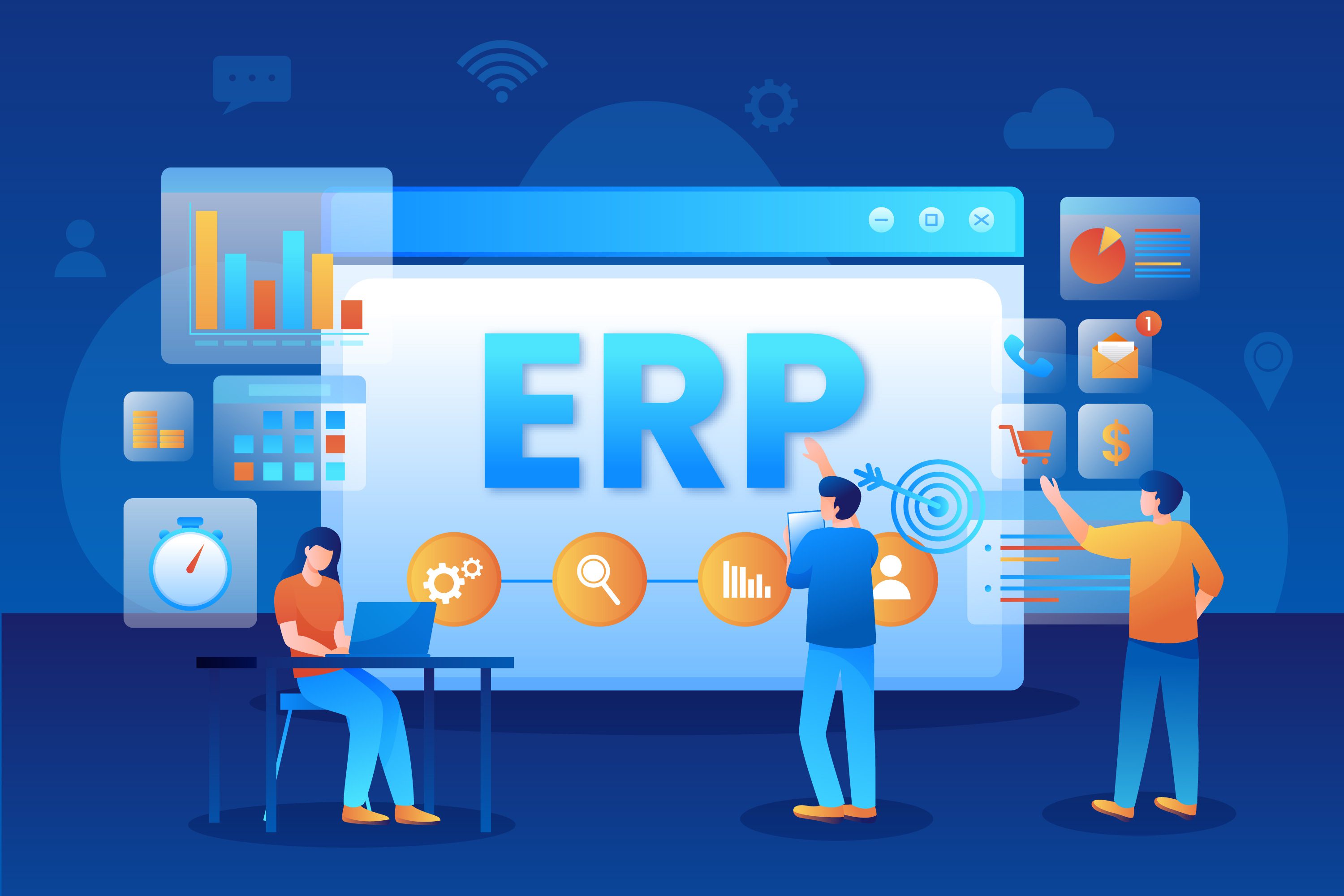
How to Use Data Analytics to Improve Your Business with an ERP System
Big companies in this digital world are flooded with data from all quarters like customer interactions, supply chain activities, financial transactions among others. Big data is an overwhelming information flood. However, if properly utilized it can lead to big improvements in how a business runs, how happy customers are, and how much profit a company makes. In increasingly large numbers, businesses are turning to a judicious blend of data analytics and Enterprise Resource Planning (ERP) systems for making sense out of this plethora of information. This duo has the strength to translate raw data into actionable insights that will assist businesses in more informed decision making thus better planning.
ERP systems act as the backbone where they integrate different processes into one harmonized system. They encompass finance and human resources as well as manufacturing, supply chain management and customer relationships among others. By combination these processes ERP system enables businesses have clear view of their operations by giving them comprehensive understanding about their operations rendering them manageable as well as capable of improvement. However; the real deal is when you merge this with Data Analytics activities. Data Analytics deals with digging deep into data sets in order to draw patterns and trends or even correlations. This leads to deeply profound intelligence derived from decoding ERP system’s data that help raise efficiency levels leading to strategic growth.
There are numerous benefits for firms that combine an ERP system with data analytics. The largest benefit is that organizations can make decisions quickly using real-time analysis of data according to its latest available shape. For instance firms may monitor inventory levels on real time basis so that they can predict demand along with tweaking procurement strategies to minimize costs associated with stockouts. Data Analytics also helps improve Customer Relationship Management by studying customer information such as buying patterns preferences and risks for churn which are then used for designing marketing campaigns improving sales services etc. Moreover financial analytics provides detailed knowledge about revenue expenses profitability while helping organizations optimize finances finding cost saving opportunities.
Establishing working data analytics within an ERP system involves some key steps. First, an organization should ensure that all data relevant to the firm is accurately captured and integrated into the ERP system. This sometimes involves cleaning up data to make it consistent and reliable. Secondly, businesses have to use advanced analytics tools and techniques including machine learning algorithms, predictive modelling, and data visualization in order to effectively analyze the data. Additionally it is vital to institute a data governance model for maintaining security as well as privacy of information which may be in line with regulations. Lastly organizations must encourage a culture of using data by training employees and providing them with resources necessary for achieving this level of skill in their everyday activities of utilizing Data Analytics during decision making processes as such becomes part of their routine operations.
Understanding ERP Systems
Think of an ERP system as the backbone of your business operations. It’s a suite of integrated applications that streamline and automate processes across various departments. By centralizing data, an ERP system provides a unified view of your business, making decision-making easier and operations more efficient. Key modules typically include finance, human resources, manufacturing, supply chain, and customer relationship management.
Nowadays enterprises face such challenges that require robust comprehensive solutions in managing their financial activities. Traditional methods of financial planning and budgeting which mainly relied on disparate systems and manual process are no longer enough. What modern enterprises need are integrated systems capable of handling multifaceted financial data, delivering real-time insights while supporting agile decision making. These challenges include cash flow management; predicting future performance; cost control; regulatory compliance assurance among others. Financial systems should also accommodate multiple currencies, tax regimes, reporting standards etc., due to the globalisation aspect of today’s business making it necessary for multinational corporations (MNCs) to have one set of books globally in different countries and legal jurisdictions. For business to address these needs they need ERP solutions that provide a single platform encompassing all their financial transactions.
ACCNU ERP (Enterprise Resource Planning) comes out as one top solution emphasis being put on the holistic approach towards finance management. ACCNU ERP makes sure that numerous finance functions become part of one system thereby eliminating any inefficiencies plus inaccuracies that come with fragmented tools for managing finances. It has an extensive feature suite designed to automate and optimize the aspects surrounding financial planning, budgeting forecasting as well as reporting. The strong analytical function by this software allows firms examine how financially healthy they are by identifying trends and making decisions that are based on data. Moreover, ACCNU ERP encourages seamless interdepartmental collaboration to ensure alignment of financial plans and budgets with the organization’s overall goals and operational realities.
This blog post explores features, benefits and implementation strategies of ACCNU ERP in relation to financial planning and budgeting. The solution provides automated budgeting facilities, real-time financial reports as well as advanced forecasting tools among others. These features enable establishments prepare adaptable budgets that expose their correct position at all times; monitor how they spend money day after day then alter any plan here if a need arises due to change in conditions. However, using ACCNU ERP goes beyond mere efficiency gains since it also enhances financial visibility, promotes compliance with regulations as well as supports strategic planning initiatives in various organizations. Careful planning and execution involving steps like needs assessment, system configuration, user training plus ongoing support is needed for implementing ACCNU ERP. In conclusion, business entities can enhance their financial planning plus budgeting processes significantly through utilizing capabilities of ACCNU ERP thus fostering sustainable growth amidst ever changing business environments.
Let's discuss, we are here to accelerate your business and ROI
The Role of Data Analytics in ERP
Data analytics is about examining data sets to draw meaningful conclusions. Integrating data analytics with your ERP system can help you:
Gain Real-Time Insights: Access up-to-date information about every aspect of your business.
Improve Decision-Making: Make informed decisions based on data-driven insights rather than intuition.
Enhance Efficiency: Identify bottlenecks and areas for improvement within your business processes.
Boost Customer Satisfaction: Understand customer behaviors and preferences to tailor your services accordingly.
Forecasting and Planning: Use historical data to predict future trends and plan strategically.
Steps to Integrate Data Analytics with Your ERP System
- Define Your Objectives
Before diving into data analytics, it’s essential to define your goals. Are you looking to improve operational efficiency, enhance customer satisfaction, or boost sales? Clear objectives will help you focus your efforts and measure success effectively.
- Choose the Right ERP System
Select an ERP system that supports data analytics and offers robust reporting and visualization tools. Popular ERP systems like SAP, Oracle, and Microsoft Dynamics have built-in analytics capabilities that can be tailored to your business needs.
- Data Integration
Ensure that all relevant data from various departments is integrated into the ERP system. This includes data from finance, sales, marketing, human resources, and supply chain. The more comprehensive your data, the more valuable insights you can derive.
- Data Cleaning and Preparation
Clean and pre-process your data to ensure accuracy and consistency. This step involves removing duplicates, handling missing values, and standardizing data formats. Clean data is crucial for reliable analytics.
- Implement Data Analytics Tools
Integrate data analytics tools with your ERP system. Tools like Tableau, Power BI, and SAS can be used to create dashboards, reports, and visualizations. These tools help in making complex data more understandable and accessible.
- Develop Dashboards and Reports
Create dashboards and reports tailored to your business objectives. For example, a sales dashboard might display key metrics like total sales, sales by region, and customer acquisition rates. Regularly review these dashboards to monitor performance and identify trends.
- Train Your Team
Ensure that your team is trained to use the ERP system and data analytics tools effectively. This includes training on how to interpret data, create reports, and use dashboards. A well-trained team can leverage these tools to make better decisions and drive business improvements.
Use Cases of Data Analytics with ERP
- Inventory Management
By analyzing historical sales data, you can predict future demand and optimize inventory levels. This helps in reducing carrying costs and avoiding stockouts, ensuring that you have the right products available at the right time.
- Financial Performance
Analyze financial data to identify trends, monitor cash flow, and improve budget forecasting. This can help in managing expenses, increasing profitability, and ensuring financial stability.
- Customer Relationship Management
Use customer data to understand buying behaviors, preferences, and feedback. This can help in personalizing marketing efforts, improving customer service, and increasing customer loyalty.
- Supply Chain Optimization
Analyze supply chain data to identify bottlenecks, improve supplier performance, and reduce lead times. This can enhance overall supply chain efficiency and reduce costs.
Challenges and Solutions
Data Quality Issues
Solution: Implement strict data governance policies and regular data audits to ensure data accuracy and consistency.
Integration Complexities
Solution: Work with experienced IT professionals and choose ERP systems that offer seamless integration with other business applications.
User Adoption
Solution: Provide comprehensive training and support to ensure that employees are comfortable using the new system and tools.
Conclusion
Integrating data analytics with an ERP system can revolutionize the way you manage your business. By turning data into actionable insights, you can make informed decisions, optimize operations, and achieve your business goals. Start by defining your objectives, choosing the right ERP system, and implementing robust data analytics tools. With the right approach, you can unlock the full potential of your business data and drive significant improvements in performance and profitability.
FAQs
Integrating data analytics with an ERP system allows businesses to transform raw data into actionable insights, enabling more informed decision-making and strategic planning. This combination helps improve operational efficiency, customer satisfaction, and overall profitability.
ERP systems centralize and integrate various business processes into one unified system, covering functions like finance, human resources, manufacturing, supply chain management, and customer relationships. This comprehensive view makes it easier to manage and optimize operations.
The key steps include capturing and integrating relevant data, cleaning and preparing the data, deploying advanced analytics tools and techniques, establishing a data governance framework, and fostering a data-driven culture through employee training.
Advanced analytics tools like machine learning algorithms, predictive modeling, and data visualization tools such as Tableau, Power BI, and SAS can be integrated with ERP systems to effectively analyze data and create insightful dashboards and reports.
Real-time data analysis allows businesses to monitor current conditions and make timely decisions. For example, firms can track inventory levels in real-time, predict demand, and adjust procurement strategies to reduce costs and avoid stockouts.
Data cleaning ensures the accuracy and consistency of the data by removing duplicates, handling missing values, and standardizing data formats. Clean data is crucial for reliable analytics, leading to more accurate insights and better decision-making.
Data analytics can analyze customer data to identify buying patterns, preferences, and churn risks. This information helps businesses tailor marketing efforts, improve customer service, and increase customer satisfaction and loyalty.
Common challenges include data quality issues, integration complexities, and user adoption. Solutions include implementing strict data governance policies, working with experienced IT professionals for seamless integration, and providing comprehensive training and support to ensure employees are comfortable using the new system and tools.
Let’s discuss, we are here to accelerate your business and ROI


